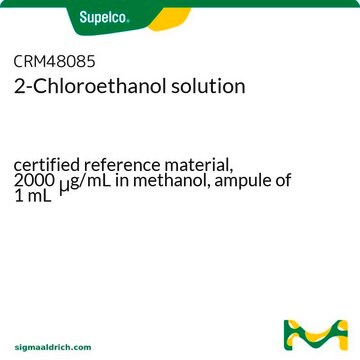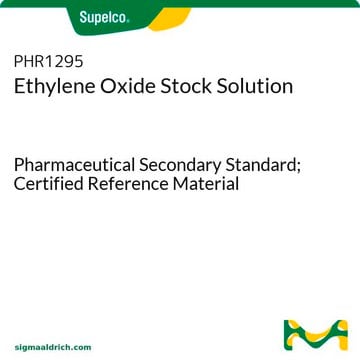If this product has an expiration or retest date, it will be shown on the Certificate of Analysis (COA, CofA). If there is no retest or expiration date listed on the product's COA, we do not have suitable stability data to determine a shelf life. For these products, the only date on the COA will be the release date; a retest, expiration, or use-by-date will not be displayed.
For all products, we recommend handling per defined conditions as printed in our product literature and website product descriptions. We recommend that products should be routinely inspected by customers to ensure they perform as expected.
For products without retest or expiration dates, our standard warranty of 1 year from the date of shipment is applicable.
For more information, please refer to the Product Dating Information document: https://www.sigmaaldrich.com/deepweb/assets/sigmaaldrich/marketing/global/documents/449/386/product-dating-information-mk.pdf
Wichtige Dokumente
48838
Ethylenoxid -Lösung
certified reference material, 50 mg/mL in methanol
About This Item
Empfohlene Produkte
Qualität
certified reference material
TraceCERT®
Qualitätsniveau
Produktlinie
TraceCERT®
Analysenzertifikat (CofA)
current certificate can be downloaded
Leistungsmerkmale
standard type calibration
Verpackung
ampule of 1 mL
Konzentration
50 mg/mL in methanol
Methode(n)
HPLC: suitable
gas chromatography (GC): suitable
Anwendung(en)
agriculture
cleaning products
cosmetics
environmental
food and beverages
personal care
Format
single component solution
Lagertemp.
2-8°C
SMILES String
C1CO1
InChI
1S/C2H4O/c1-2-3-1/h1-2H2
InChIKey
IAYPIBMASNFSPL-UHFFFAOYSA-N
Suchen Sie nach ähnlichen Produkten? Aufrufen Leitfaden zum Produktvergleich
Allgemeine Beschreibung
Ethylenoxid ist eine toxische und entzündliche Flüssigkeit, die durch Dampfphasen-Oxidation von Ethylen gewonnen werden kann.[1] Es kann in der Synthese von Ethylenglycol[2], Glycolethern, Tensiden und Ethanolaminen verwendet werden.[1] Es ist eine industriell wichtige chemische Substanz, die als Begasungsmittel zur Sterilisation von zahnmedizinischen und medizinischen Geräten verwendet werden kann.[2]
Anwendung
Sonstige Hinweise
Rechtliche Hinweise
Signalwort
Danger
Gefahreneinstufungen
Acute Tox. 3 Dermal - Acute Tox. 3 Inhalation - Acute Tox. 3 Oral - Carc. 1B - Eye Dam. 1 - Flam. Liq. 2 - Muta. 1B - Repr. 1B - Skin Corr. 1 - STOT RE 2 - STOT SE 1
Zielorgane
Eyes,Central nervous system, Nervous system
Lagerklassenschlüssel
3 - Flammable liquids
WGK
WGK 3
Flammpunkt (°F)
50.0 °F - closed cup
Flammpunkt (°C)
10 °C - closed cup
Persönliche Schutzausrüstung
Eyeshields, Faceshields, Gloves
Zulassungslistungen
Zulassungslistungen werden hauptsächlich für chemische Produkte erstellt. Für nicht-chemische Produkte können hier nur begrenzte Angaben gemacht werden. Kein Eintrag bedeutet, dass keine der Komponenten gelistet ist. Es liegt in der Verantwortung des Benutzers, die sichere und legale Verwendung des Produkts zu gewährleisten.
Hier finden Sie alle aktuellen Versionen:
Analysenzertifikate (COA)
It looks like we've run into a problem, but you can still download Certificates of Analysis from our Dokumente section.
Wenn Sie Hilfe benötigen, wenden Sie sich bitte an Kundensupport
Besitzen Sie dieses Produkt bereits?
In der Dokumentenbibliothek finden Sie die Dokumentation zu den Produkten, die Sie kürzlich erworben haben.
Kunden haben sich ebenfalls angesehen
-
How can I determine the shelf life / expiration / retest date of this product?
1 answer-
Helpful?
-
-
How is shipping temperature determined? And how is it related to the product storage temperature?
1 answer-
Products may be shipped at a different temperature than the recommended long-term storage temperature. If the product quality is sensitive to short-term exposure to conditions other than the recommended long-term storage, it will be shipped on wet or dry-ice. If the product quality is NOT affected by short-term exposure to conditions other than the recommended long-term storage, it will be shipped at ambient temperature. As shipping routes are configured for minimum transit times, shipping at ambient temperature helps control shipping costs for our customers. For more information, please refer to the Storage and Transport Conditions document: https://www.sigmaaldrich.com/deepweb/assets/sigmaaldrich/marketing/global/documents/316/622/storage-transport-conditions-mk.pdf
Helpful?
-
-
Please supply detailed instructions how to open and extract the chemical from its packing container. The form of the vial is not familiar to me and due to chemical's high toxicity and volatile content we need to handle it with extra care.
1 answer-
The ampule may be opened by holding the top firmly with one hand and the body of the ampule in the other hand. Firmly and steadily bend the cap away from the break point or neck until the vial snaps. Dispose of the cap (containing the broken vial top) into a sharps bin. The item is intended for single-use only. Please review the product SDS for recommended personal protective equipment.
Please see the links below to review products that may be useful in opening ampules:
https://www.sigmaaldrich.com/product/aldrich/z693847
https://www.sigmaaldrich.com/substance/ampulebreakercollar1234598765Helpful?
-
Active Filters
Unser Team von Wissenschaftlern verfügt über Erfahrung in allen Forschungsbereichen einschließlich Life Science, Materialwissenschaften, chemischer Synthese, Chromatographie, Analytik und vielen mehr..
Setzen Sie sich mit dem technischen Dienst in Verbindung.











